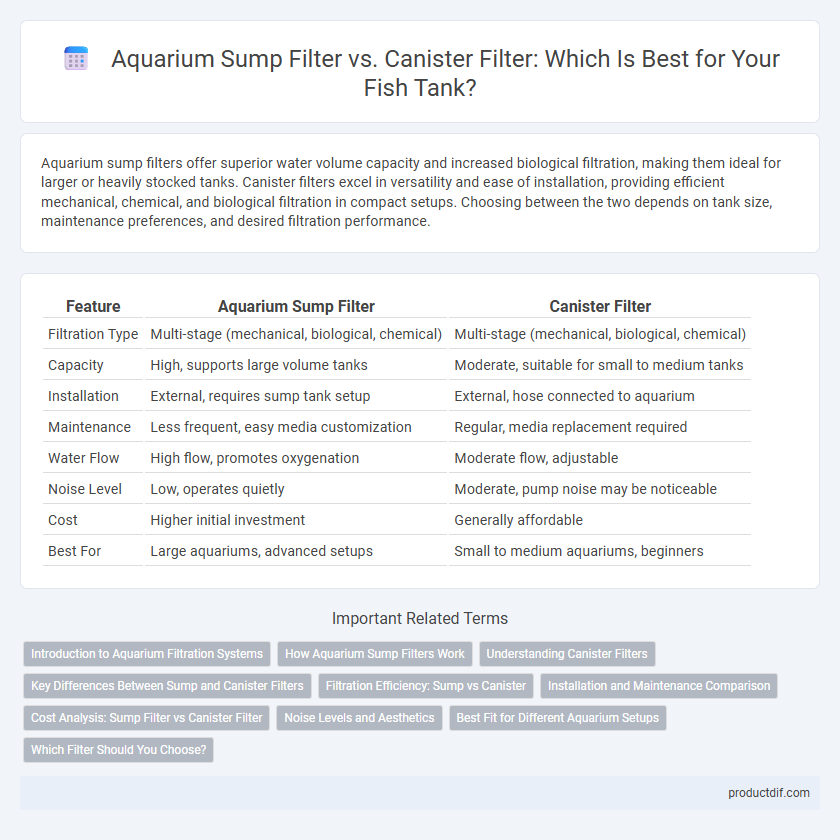Aquarium sump filters offer superior water volume capacity and increased biological filtration, making them ideal for larger or heavily stocked tanks. Canister filters excel in versatility and ease of installation, providing efficient mechanical, chemical, and biological filtration in compact setups. Choosing between the two depends on tank size, maintenance preferences, and desired filtration performance.
Table of Comparison
| Feature | Aquarium Sump Filter | Canister Filter |
|---|---|---|
| Filtration Type | Multi-stage (mechanical, biological, chemical) | Multi-stage (mechanical, biological, chemical) |
| Capacity | High, supports large volume tanks | Moderate, suitable for small to medium tanks |
| Installation | External, requires sump tank setup | External, hose connected to aquarium |
| Maintenance | Less frequent, easy media customization | Regular, media replacement required |
| Water Flow | High flow, promotes oxygenation | Moderate flow, adjustable |
| Noise Level | Low, operates quietly | Moderate, pump noise may be noticeable |
| Cost | Higher initial investment | Generally affordable |
| Best For | Large aquariums, advanced setups | Small to medium aquariums, beginners |
Introduction to Aquarium Filtration Systems
Aquarium filtration systems are essential for maintaining water quality and a healthy aquatic environment. Aquarium sump filters provide large filtration capacity and flexibility by housing various filter media beneath the tank, promoting efficient biological, mechanical, and chemical filtration. Canister filters offer compact, external filtration with high flow rates, ideal for tanks that require powerful water circulation and thorough purification.
How Aquarium Sump Filters Work
Aquarium sump filters operate by drawing water from the main tank into a separate filtration compartment located below or adjacent to the aquarium, where it passes through mechanical, chemical, and biological filtration media before being pumped back into the tank. This system increases the overall water volume, improving stability and providing a hidden space for equipment like heaters and protein skimmers. The continuous flow and large filtration capacity of sump filters make them highly effective for maintaining water quality in reef and freshwater aquariums.
Understanding Canister Filters
Canister filters provide superior filtration for aquarium setups by housing multiple filter media types in a sealed, external unit, ensuring efficient mechanical, chemical, and biological filtration. They support larger water volumes and higher flow rates compared to aquarium sump filters, making them ideal for complex tank ecosystems. Maintenance involves easy media replacement without disturbing the aquarium, contributing to stable water quality and healthier aquatic life.
Key Differences Between Sump and Canister Filters
Aquarium sump filters offer larger filtration capacity, superior biological filtration, and customizable media options, making them ideal for larger or heavily stocked tanks. Canister filters provide compact, sealed units with efficient mechanical, chemical, and biological filtration, suitable for medium-sized aquariums requiring easy maintenance. Key differences include sump filters' integration with the tank system versus canister filters' external placement, as well as sump filters' ability to house additional equipment like heaters or protein skimmers.
Filtration Efficiency: Sump vs Canister
Sump filters offer superior filtration efficiency by providing larger media capacity and enhanced mechanical, biological, and chemical filtration stages, promoting optimal water quality in aquariums. Canister filters, while space-saving and effective, typically have smaller media volumes, which may reduce prolonged biological filtration compared to sump systems. The choice between sump and canister filters hinges on specific aquarium size and filtration needs, with sump filters excelling in high-capacity, heavily stocked tanks due to their advanced filtration capabilities.
Installation and Maintenance Comparison
Aquarium sump filters require a more complex installation involving additional plumbing and space beneath the tank, while canister filters are compact and connect externally with simple hoses. Maintenance of sump filters involves cleaning multiple components and regularly checking water flow, whereas canister filters are easier to service with removable media trays that simplify cleaning. Both systems improve filtration efficiency, but sump filters demand more routine attention and technical setup compared to the user-friendly maintenance of canister filters.
Cost Analysis: Sump Filter vs Canister Filter
Aquarium sump filters typically have a higher initial cost due to the complexity of installation and the need for additional tank space, but they offer long-term savings through easier maintenance and greater filtration capacity. Canister filters generally cost less upfront and are more compact, making them suitable for smaller tanks, but replacement media and frequent cleaning can increase ongoing expenses. Choosing between the two depends on the aquarium size, budget constraints, and maintenance preferences.
Noise Levels and Aesthetics
Aquarium sump filters operate quietly as they are typically housed below the tank, minimizing noise disturbance and hiding equipment for a cleaner aesthetic. Canister filters, while also relatively quiet, tend to produce slightly more noise due to external motor and hose vibrations, and their visible setup can impact the aquarium's overall appearance. Choosing between the two depends on prioritizing near-silent operation with concealed components or a compact external solution with manageable noise.
Best Fit for Different Aquarium Setups
Aquarium sump filters provide superior water volume capacity and enhanced filtration for large or complex reef tanks, making them ideal for saltwater setups that require stable water parameters and additional equipment housing. Canister filters excel in smaller freshwater aquariums due to their compact design, efficient multi-stage filtration, and ease of maintenance, offering versatility for planted tanks and community fish setups. Selecting the best filter depends on tank size, species sensitivity, and the level of filtration customization needed for optimal aquatic health.
Which Filter Should You Choose?
Choosing between an aquarium sump filter and a canister filter depends on tank size and maintenance preferences. Sump filters offer greater water volume and superior biological filtration, ideal for large or heavily stocked aquariums. Canister filters are compact, efficient, and easier to install, making them suitable for medium-sized tanks and owners seeking low-maintenance solutions.
Aquarium Sump Filter vs Canister Filter Infographic

 productdif.com
productdif.com